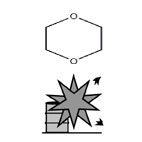| Case Name |
Explosion during transfer of dioxane by compressed air |
| Pictograph |

|
| Date |
March 17, 1969 |
| Place |
Yokohama, Kanagawa, Japan |
| Location |
Laboratory |
| Overview |
An explosion occurred at a research institute of a confectionery company in Yokohama, Kanagawa, during transferring a mixture of dioxane and 3 kg of sodium sulfate anhydride from a drum can to a reactor for trial manufacture of pesticide. Dioxane might have reacted with oxygen in the air, and might generated peroxide, and an explosion occurred in the drum can. The explosion was considered to have been triggered by local overheating of the drum can or by impact due to a collision between a vinyl chloride pipe and the drum can. |
| Incident |
On transferring dioxane in a drum can to a reactor by compressed air, the drum can exploded. The drum can was indirectly heated by warm water because the melting point of dioxane is as low as 11.8 °C. |
| Processing |
Research and development |
| Process Flow |
Fig2.Unit process flow
|
| Substance |
Dioxane, Fig3 |
| Type of Accident |
Explosion |
| Sequence |
Three kilograms of sodium sulfate anhydride (Na2SO4) were added to dioxane in the drum can. The mixture was transferred to a reactor (100 L) with compressed air using vinyl chloride tubing. Local overheating of the mixture or impact as a result of a collision between the vinyl chloride pipe and the bottom of the drum can might have been the cause of the explosion. |
| Cause |
Dioxane produced peroxide due to a reaction with compressed air. Local overheating of the drum can or impact by a collision between the pipe and the drum can was the cause of the explosion. |
| Knowledge Comment |
1. Flammable material should be pressurized with inert gas. Oxygen under high pressure is a strong oxidizer. Dioxane has two ether bonds in its molecular structure, and it is easily presumed that it forms peroxide.
2. External heating of a drum can is likely to result in local overheating. |
| Background |
Dioxane and hydrocarbons should not be pressurized by air. This fundamental rule was ignored by managers and researchers. |
| Incidental Discussion |
A drum can is not designed to be resistant to both internal and external pressure. Transferring by compressed air from a drum can is not allowed. |
| Reason for Adding to DB |
Example of preventable explosion caused due to transfer of combustibles with compressed air |
| Scenario |
| Primary Scenario
|
Ignorance, Insufficient Knowledge, Insufficient Study, Poor Value Perception, Poor Safety Awareness, Insufficient Safety Measure, Inadequate Risk Recognition, Malicious Act, Rule Violation, Contact Pressured Air with Fllamable Material, Usage, Operation/Use, Inadequate Heating Method, Bad Event, Chemical Phenomenon, Peroxide Generation, Secondary Damage, External Damage, Explosion, Bodily Harm, Injury
|
|
| Sources |
Masamitsu Tamura., Masahide Wakakura. Dioxane explosion. Reaction danger-accident case and analysis - p.167(1995)
|
| Number of Injuries |
2 |
| Physical Damage |
Dioxane 15 L |
| Multimedia Files |
Fig3.Chemical formula
|
| Field |
Chemicals and Plants
|
| Author |
YOSHINAGA, Jun (Graduate School of New Frontier Sciences, The University of Tokyo)
TAMURA, Masamitsu (Center for Risk Management and Safety Sciences, Yokohama National University)
|